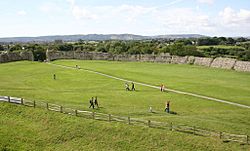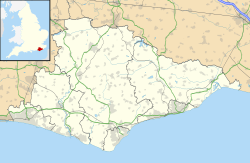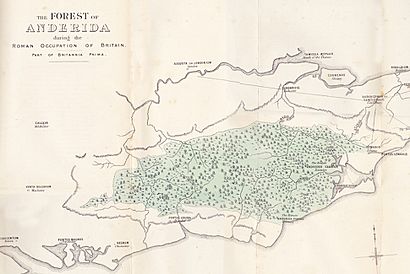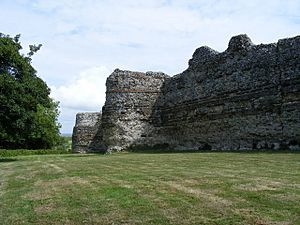Anderitum facts for kids
Quick facts for kids Anderitum |
|
|---|---|
| East Sussex, England, UK | |

View from the castle inner bailey showing the outer Roman curtain wall
|
|
|
Location in East Sussex
|
|
| Coordinates | 50°49′08″N 0°20′02″E / 50.8188°N 0.3338°E |
Anderitum (also called Anderida) was an important Roman fort built along the coast of Britannia (which is now England). It was part of a group of forts known as the Saxon Shore forts. These forts were built to protect the coast from invaders.
The ruins of Anderitum are located near the village of Pevensey in East Sussex, England. The Romans built this fort around the year 290. It was later abandoned in 471 after being attacked. After the Romans left, Saxons lived there. Much later, in the 11th century, the Normans built a castle inside the old Roman fort. This castle is known today as Pevensey Castle.
During World War II, the old Roman walls and medieval castle were used for modern defense. Small concrete bunkers, called pillboxes, were even built into the Roman walls.
Contents
What Does the Name Anderitum Mean?
The name Anderitum comes from old Celtic words. It combines "ande-" (meaning "great" or "intensive") and "ritu-" (meaning "a ford" or a shallow place to cross water). So, the name likely means "Great Ford."
Later, during the Saxon period, the nearby forest became known as Andredes Weald. This means "The Forest of Andred." It is thought that some Roman-British people continued to live in this forest even after the Saxons arrived.
Where Was Anderitum Located?
The fort was built on what used to be a piece of land sticking out into the sea. This land was surrounded by coastal marshes. The sea covered these marshes on three sides, creating a safe place for ships to land.
This marshy area had small islands that stayed above water at high tide. Places like Rickney and Pevensey got their names from an old English word for "island."
Unlike many other Roman forts, there wasn't a large town or village built just outside Anderitum's walls. This was probably because the fort was on a narrow piece of land, so there wasn't much room for more buildings.
When Was Anderitum Built?
Archaeologists believe the fort was built around 290 AD. They found wooden supports under the Roman walls. By studying these wood samples, they could figure out the exact year they were cut down.
Many other Saxon Shore forts were also built or rebuilt around this time. This was part of a big plan to improve the defenses of Roman Britain. Anderitum might have even been built to protect Roman Britain from Rome itself!
- A Roman general named Carausius took control of Britain in 286 AD. He declared himself emperor.
- Another leader, Allectus, killed Carausius in 293 AD.
- Then, in 296 AD, the Roman emperor Constantius Chlorus invaded Britain to take back control.
Coins from both Carausius and Allectus have been found in the fort's foundations. This helps prove when it was built. A later coin from 330–335 AD was also found. This suggests the fort might have been repaired or rebuilt around that time.
Anderitum was a very important part of the Saxon Shore forts. These forts stretched along the coast from Hampshire to Norfolk. They likely worked with Roman naval units across the English Channel. Their job was to stop pirate ships from getting through. By being at a key harbor, Anderitum helped the Romans control who could access the coast.
How Was Anderitum Built?
Building the fort was a huge job! Experts think it took about 160,000 days of work. This would be like 285 people working for two years, or 115 people working for five years.
At least four different groups of builders worked on the walls. Each group built a section about 20 meters (65 feet) long. They used slightly different styles, like varying the number of tile layers in the walls. This might mean they used whatever building materials were available at the time.
A massive amount of stone and mortar was needed. It would fill about 31,600 cubic meters (41,300 cubic yards). We don't know exactly how these materials were brought to the site. It would have taken about 600 boat loads or 49,000 wagon loads! It seems most likely that the materials were brought by sea.
The fort's main wall was not built all at once. It was built in sections. You can still see vertical breaks in the stone where different sections met. The wall was built on strong foundations. These foundations were made of rubble and wood set into a deep ditch. Large oak posts were driven into the ground. Then, they were packed with flint and clay. A wooden frame was placed on top, also filled with flint and clay. Finally, cement covered the foundation before the walls were built.
Who Guarded Anderitum?
Records show that Anderitum was home to a Roman army unit called the numerus Abulcorum. These were infantry soldiers who guarded the borders.
The records also mention other army and naval units linked to the fort. This suggests that the original soldiers might have been moved to Gaul (modern-day France). They were then replaced by the numerus Abulcorum. These soldiers were likely an elite group. They might have been foederati, which were troops from allied tribes who fought for Rome.
What Happened After the Romans Left?
After the Romans left Britain, local people continued to live in the fort. The old Celtic name for the fort was still used even into the Saxon period.
The Anglo-Saxon Chronicle tells us that the Saxons attacked Andredes ceaster (Anderitum). They drove the people living there into the nearby forest, which was called the "Andred'sley" or "Andreds Weald."
- The Chronicle says: "A.D. 477. This year came Ælle to Britain, with his three sons... landing at a place that is called Cymenshore. There they slew many of the Welsh; and some in flight they drove into the wood that is called Andred'sley."
This event is now thought to have happened around 471 AD. We are not sure if people continued to live in the fort right after this attack. However, it seems a Saxon community settled there by the mid-6th century. They left behind pottery, glass, and other items. By the late Anglo-Saxon period, Pevensey was a busy fishing port and a place where salt was made.
The Later Castle at Pevensey
When William the Conqueror invaded England in 1066, his army landed near Pevensey. They stayed for a night in a temporary camp inside the old Roman fort. The next day, they left for Hastings before the famous Battle of Hastings.
Around 1100, the Roman fort was turned into a proper castle. People continued to live and use the castle until the time of Elizabeth I (the Elizabethan era).
See also
 In Spanish: Anderitum para niños
In Spanish: Anderitum para niños




